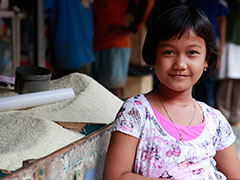Informing Policymakers for Better Allocation of Research & Development Resources
Motivation

Source: flickr (IFPRI/Dani Bradford). A young girl shopping with her mother at a local market in Jakarta, Indonesia.
Increasingly, policymakers are recognizing that greater investment in agricultural research and development (R&D) is vital for increasing agricultural productivity. Indicators on the size and scope of R&D capacity and investments allow performance, inputs, and outcomes to be measured, monitored, and benchmarked. IFPRI’s Agricultural Science and Technology Indicators (ASTI) initiative provides comprehensive quantitative and qualitative information and analyses on investment, human capacity, and institutional trends in agricultural R&D in low- and middle-income countries. ASTI, with support from the Bill & Melinda Gates Foundation, the Canadian International Development Agency (CIDA), the Economic Research Service of the US Department of Agriculture (USDA), and USAID allows countries to track their progress over time and compare it to other countries. The initiative also raises awareness of ongoing challenges and guides informed decisions on funding, capacities, and institutional arrangements.
Outcomes
- During 2011–2012, ASTI released a series of country notes and regional assessments of recent trends in investment and human-resource capacity in public agricultural R&D up to the year 2008 for Sub-Saharan Africa and South Asia. Datasets for Sub-Saharan Africa have been updated to now cover 2011. The ASTI team finalized a new series of country factsheets (over 60 factsheets) as well as a regional reports.
- ASTI also produced a new global assessment describing recent trends in agricultural R&D spending. This report was released at the 2012 Global Conference on Agricultural Research for Development (GCARD) in Uruguay and constituted an important input in the conference’s discussions. The report revealed that following a decade of slowing growth in the 1990s, global public spending on agricultural R&D increased steadily during 2000–2008. Most of this growth was largely driven by positive trends in few countries such as China, India, and a number of other larger, more-advanced middle-income countries.
- ASTI's outputs are frequently referenced in high-level meetings and reports:
- The 2012 G8 Accountability Report and the Group of 20 (G20) Interagency Report have been very important in raising stakeholder awareness of the value of ASTI data and have called for sustainable support for ASTI.
- The ASTI global assessment was also circulated by the USDA Under-Secretary to all participants in the G20 Meeting of Agricultural Chief Scientists in September 2012.
- ASTI data was featured prominently in the background report that was prepared for the Science Agenda for Agriculture in Africa (S3A), and was discussed at the African Heads of State meeting in 2014. ASTI’s new data and outputs for the region undoubtedly played an important role in informing the debates surrounding S3A. The strategies developed for the S3A include the implementation of CAADP, increasing domestic public and private sector investment, creating the enabling environment for sustainable application of science for agriculture, and to double current level of Agricultural Total Factor Productivity (ATFP) by 2025 through application of science for agriculture.
- ASTI was also featured prominently in the UN's Food and Agriculture Organization's State of Food and Agriculture 2012, the Economist Intelligence Unit's newly developed Global Food Security Index, the Organisation of Economic Co-operation and Development’s Improving Agricultural Knowledge and Innovation Systems book, and the Agricultural Technology for Development report by the United Nations Secretary-General.
- Since 2013, ASTI data have been hosted on FAOSTAT, a platform that enables more users and partners to utilize the data expanding the coverage of ASTI dissemination and increased recognition of ASTI in agriculture-related fields.
- By 2014, ASTI analyses have become critical components of government's strategic plans for the agricultural sector in Mozambique and India.
- In 2013, the Ministry of Agriculture of Mozambique used ASTI data to produce a paper on the analysis of the current status of agricultural research and extension for PEDSA--the government's strategic plan for the development of the agricultural sector for the period of 2011 to 2020.
- India developed an online database on research spending and produced a paper in 2013 using ASTI data and reports. This was part of it National Agricultural Innovation Project operated by India's National Centre for Agricultural Economics and Policy Research.
- In 2014, ASTI’s synthesis report on the ASTI/CORAF project, which included the main findings and a set of policy recommendations, will feed into a regional agricultural research policy strategy under development by CORAF for the ECOWAS Council of Ministers of Agriculture.
- ASTI data and analyses have been instrumental in helping policymakers understand levels of agricultural R&D investment and human capacity and where to increase them, if necessary. ASTI has improved the relevance of its outputs for policymakers, R&D managers, and other stakeholders and has significantly increased its communication and outreach efforts since 2011. During the launch of the most recent data collection round in Africa south of the Sahara, it became clear that many African partners and other in-country stakeholders had used ASTI materials to influence the public debate on policy decisions in their respective countries. ASTI’s financial data have also been extensively used as an advocacy tool when seeking more R&D funding from the government or donor organizations. According to a December 2010 impact assessment of the project, "ASTI has been a productive program, creating a unique international public good. It produces agricultural research investment data and publications widely used by national, regional, and international audiences to assess the levels and trends in research funding and capacity. The data are used in some cases to influence agricultural research budgets."
- The estimated value of ASTI data use in Kenya and Tanzania in 2015 is approximately US$3 million.


